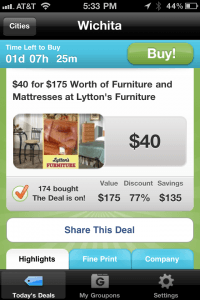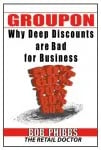[This is an excerpt from my ebook, Groupon: Why Deep Discounts are Bad for Business]
Part 2 of a series of 11 on the perils of discounting for businesses. Today’s post explores more about the financial costs of couponing, discounting, and utilizing Groupon and their online clones, coupon blogs, and their ilk.
Introduction
This is not a consumer blog. I’m unabashedly in the business owners’ corner. Whether as a multi-national manufacturer, a regional chain, a distributor, an established franchisor, a new franchisee, or a single store operator. My business is their business.
As a retail expert who speaks and as an information entrepreneur, I speak and write to help businesses be more successful and keep the engine of commerce profitable.
I said it ten years ago with my first book, You Can Compete: Double Sales Without Discounting, again in my newest book, The Retail Doctor’s Guide to Growing Your Business (Wiley & Sons) and it is a hallmark of my motivational speeches to business owners around the world: Discounting doesn’t build your business.
I haven't seen anyone delve into this as deep as I'm about to so i hope you'll stay involved, join my Facebook Fan page or sign up to the RSS feed of the blog, tell your friends, tweet, "like," and let me know your thoughts.
Cherry Picking
When you use coupons, offer a Groupon, Entertainment Book, Bloomspot, you name it, you are more likely to be cherry-picked because they're typically a value of services for 1/2 ( or more!) Check out this one from last Saturday: $175 worth of furniture for $40. 
That means shoppers can get the top 20% of your best-selling, first-run SKUs at a deal. So you end up out of stock with the very things you need to be profitable.
Price Matching
When I sold western wear in the ’80s, we had a competitor regularly run coupon sales on lizard boots for $199 when the ones I was carrying were $269. Invariably the competitor wouldn’t have the customer’s size, they’d come to me and ask to price match and get the same deal. My response was, “No dice.”
"Why not?" they'd ask.
I’d tell them, “Ours would be free if we were out of stock. But we do have your size. And they fit. And you can wear them out tonight. Will that be a box or a bag?”
90% of the time, I’d get, “Box, please.”
It costs money to stock a store, staff a spa, or run a successful kitchen for your restaurant.
Matching a competitor's price takes everything out of your business and reduces it to whatever unscrupulous, low-life, dirt-scratching competitor across town or down the block is offering. Often at a loss.
It ignores the probable fact the competitor’s parent purchased the land, building, and merchandise eons ago, so their daughter or son has no debt load.
On the other hand, you might have taken out a home equity loan at the top of the housing bubble and now have more bills than receipts.
Further, you have fallen on your sword when you price-match or sign up for an online “deal of the day” discount past your profitable price.
Oh, you may not feel it at first as the blood seeps out. You're so horny for the deal you tell yourself, “I had to do it to make the sale.”
That’s like the Black Knight in the Monty Python movie, “It's not so bad, it’s only a flesh wound.”
But as you do it over and over again, it gets easier. When such a shop inevitably loses its way after a pattern of this price matching or couponing, the owner realizes (too late) the path to failure was a determined effort to avoid the truth about what hand they had in the demise of their own profits.
The good news is that I am writing this series to warn you now.
Discounting to others who don't know you doesn’t work! Profits do!
Profit comes from taking the risk of what customers will want to buy from you.
Rewarding Risk
Like some type of fortuneteller peering into a cloudy crystal ball, you (whether you are a manufacturer, distributor, franchise, or mom-and-pop) are buying merchandise in anticipation of what your customers might want in the future.
It’s an inexact science for new merchandise since it is unproven. It's risky.
At least 50% of the time, you are either wrong or the merchandise doesn’t turn at least twice to give you a good return on your investment. Of the remaining 50%, 20% are fantastic, barn-burner, stellar money-makers. But you may not be able to keep them in stock because the first 50% that has taken up your open-to-buy is gathering dust on your sales floor, limiting your ability to juice sales.
Without the reward from taking those risks and the profits that result, you end up with stores filled with boatloads of boring merchandise. You might have some very happy sales representatives but an unhappy spouse as a result.
Boring merch is what is wrong in a lot of stores these days.
So why would you reward another company’s customers with a virtual run on your balance sheet either through price-matching, Groupons, or other discounts?
Good question.
Tomorrow: The Alien Danger To Business With Groupon (and their ilk)
Here are the previous posts in case you missed them:

